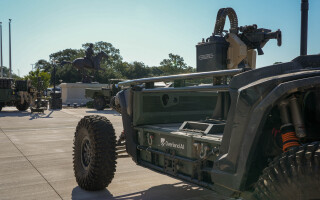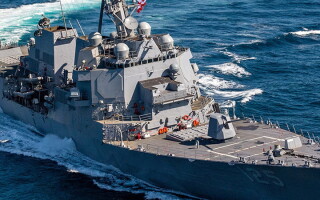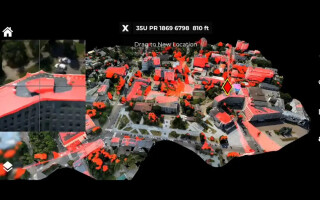Vetronics: Three key challenges
StoryAugust 07, 2014
The concept of the VICTORY intra-vehicle networking architecture is well understood, and will deliver real benefits. However, that?s not to say that the implementation of the architecture does not represent some tough challenges.
The Scout SV is the reconnaissance variant of the Specialist Vehicle armored fighting vehicle (AFV) developed by General Dynamics UK for the British Army. It was developed as part of the Future Rapid Effects System’s (FRES) SV program of the UK and is, in many ways, highly representative of the latest trends in vehicle computing architectures.
Most notably, the vehicle’s electronics architecture is open – designed for flexibility and the ability to create multiple vehicles of different types using the same architecture; it was also designed for ease of upgrade as needs change throughout its projected lifetime. From that point of view, it mirrors the goals of the U.S. Army’s VICTORY (Vehicular Integration for C4ISR/EW [Command, Control, Communication, Computers, Intelligence, Surveillance, and Reconnaissance/Electronic Warfare] Interoperability) program, which seeks to allow platforms to accept future technologies without the need for significant redesign. The Scout SV and VICTORY programs also place substantial emphasis on the need to make the best possible use of size, weight, and power (SWaP) and share a desire to maximize the availability of actionable data.
The direction of vetronics in the future is set: At its heart is a high-speed network. Attached to that network at one end are sensors, while at the other end is the necessary hardware to deliver the means for timely, meaningful action to the vehicle crew. Between the two ends lie a variety of processing modules, data servers, and video servers that act on, or store, the sensor-derived data and make it available in comprehensible, usable form in close to real-time.
Three key challenges
The architectural concept is simplicity itself; the devil, inevitably, is in the detail. Such an approach presents three key challenges.
On-vehicle network capacity
The first of these is in the sheer volume of sensor-derived data to be transmitted and processed. As the character of Joe (played by Clint Eastwood) famously pointed out in the movie “For A Few Dollars More” – “A man’s life in these parts can depend on the merest scrap of information.” He might have been talking about the military’s requirement for superior situational awareness. It’s that quest for greater detail in video that is driving the military from the long-favored VGA (640 x 480 pixels) resolution towards the enhancement of HD. That’s the difference between 300,000 pixels to be transmitted – and almost seven times as many. Codecs such as HEVC/H.265 may have a role to play in reducing the traffic burden, but there is a concomitant processing overhead that may be unacceptable as the stream is encoded and decoded. It’s not just about quantity of pixels, of course, but also about the rapid proliferation in both the number and types of sensors. Video may be the most demanding, but video data is also competing with audio data, radar/sonar data, and radio frequency (RF) data.
The challenge, of course, is to combine all that sensor-derived data in order to identify events of interest: audio and video combined, for example, can represent far more powerful information than either one taken on its own.
Today’s network architecture typically comprises a 10-Gigabit Ethernet backbone, with 1-Gigabit links to the attached devices. That bandwidth is at its limits today, and is likely to be pushed beyond them in the not-too-distant future.
As an interesting aside: it is possible to propose that, in fact, VICTORY/Scout SV are the military implementation of the buzz phrase on everyone’s lips: the Internet of Things (IoT). The IoT envisions an Internet driven, not by people as it is today, but by machines communicating with each other. Driving the IoT – or perhaps, an inevitable outflow from it – is Big Data: a profusion of data derived from hugely disparate sources. The challenge, for both commerce and the military, is to derive meaningful information from that plethora of accumulated data. It could be said that we are entering the era of the “Battlefield of Things.”
Network security
If on-vehicle network capacity is one challenge, a second is the security of that network – both logical and physical. Physically, it needs to provide redundancy: Total network failure, given the complete dependency of the vehicle, is unthinkable. Neither should failure of any part of the network be catastrophic: Alternative routes between nodes need to be defined and implemented by intelligent switches.
Logical security implies that the data carried by the network should be secure from interception, tampering, and the like. Increasingly, the military is focusing on what are described as “red” and “black” networks – referring to plain text as opposed to encrypted information – each with differing security needs. Increasingly, the military is turning to commercial technologies – not just to provide network security, but also to provide the sophisticated network management deployed by financial institutions and other high-security applications.
In the same ways as commercial high performance computing (HPC) technologies – such as InfiniBand and Intel processors – are finding rapid acceptance in high performance embedded computing (HPEC) in military environments, so too the military is turning to network security from companies like network-security provider Juniper Networks with its Junos operating environment (see Figure 1). The firewall, intrusion prevention and detection, and extensive Quality of Service (QoS) capabilities of Junos enable secure IPv4/IPv6 connectivity for military vehicles, aircraft, and forward operating bases supporting net-centric operations.
Figure 1: GE’s RTR8GE rugged router features the Junos operating system from Juniper Networks.
(Click graphic to zoom by 1.9x)
SWaP
The third challenge is perhaps the most significant: SWaP is a comparatively recent term, and reflects the growing military need for solutions that are small in size and weight, and low in power consumption and heat dissipation. Typically, the need for optimum SWaP is associated with the proliferation of smaller platforms such as unmanned aerial vehicles (UAVs) or wearable systems.
It is, however, no less of a requirement in sizeable land vehicles, such as the Scout SV, despite these vehicles’ apparently generous provision of space and power and their perceived relative immunity to weight addition. The fact is that, in every platform, size, weight, and power are at a premium – and whatever the platform, cooling is a challenge.
What was perhaps most exciting about NVIDIA’s announcement of the Tegra K1 processor (see Figure 2) at the GPU Technology Conference in March was how precisely the company addressed the requirement to deliver maximum computing capability in the smallest size while consuming the least power and thus dissipating the least heat. General-purpose computing on graphics processing units (GPGPU) has fast become a mainstay of HPEC because the inherent parallelism of graphics processors lends itself readily to the innate nature of many ISR problems. The 192 cores of the Tegra, for example, makes the Intel Core i7’s four cores look positively puny (although it goes without saying that the Core i7 is significantly better suited to many tasks than any GPU).
Figure 2: NVIDIA’s Tegra K1 features 192 cores, making it ideal for compute-intensive applications in SWaP-constrained environments.
(Click graphic to zoom by 1.9x)
The real game changer, though, is the tiny space that those 192 cores occupy – and the fact that the Tegra K1 consumes as little as 5 or 10 W of power. Compare that with the 2,000 W consumed by the most capable GPGPU-based HPEC subsystems. Once Tegra K1-based products reach the rugged market, it is possible to imagine tiny supercomputers located in every available nook and cranny of just about any land vehicle. A step like this could transform what vetronics is all about.
NVIDIA has also made the Tegra K1 Compute Unified Device Architecture (CUDA)-capable, and thus able to run the same code as that developed for significantly more powerful (and larger) CUDA-based systems. The opportunity to design an application only once, but be able to run it on a massively broad range of target platforms, is one that few developers would shy away from.
New cooling technologies needed
For more traditional embedded computing platforms, however, cooling remains a continuing challenge. It is widely recognized, for example, that fans are far from favored by the military – especially in ground vehicles, with their extended loiter times – because of their noise, and also because their mechanical nature means that they are inherently prone to failure and thus require access for maintenance. Less well-recognized is the EMC profile that fans represent, because of the requirement to provide ingress and egress for air, making discovery easier.
What is needed are radically new and innovative cooling technologies. GE has been working with DARPA on the development of such technologies – including the Nano Thermal Interface, the Thermal Management Technology Bridge, Thermal Ground Plane, and Dual Cool Jets (see Figure 3). All show promise in mitigating, or even eliminating, constraints in computing performance resulting from cooling limitations and making it possible to deploy more powerful processors and subsystems in environments that were previously unthinkable.
Figure 3: Dual Cool Jets is one of several innovative cooling technologies that GE has developed in conjunction with DARPA.
(Click graphic to zoom by 1.9x)
The Scout SV AFV represents essentially the proverbial blank sheet of paper in design terms – and, as noted at the outset, is an excellent exemplar of the type of vehicle electronics architecture that VICTORY envisages. Interchangeability of subsystems is designed into the platform. According to General Dynamics, the hull and power train growth are designed for a 25 percent increase in weight, and there is 100 percent growth capacity in subsystem electrical power and data throughput.
Upgrades to existing vehicles provide a significantly tougher challenge. Nevertheless, the technologies that are beginning to appear may make even these platforms easier to upgrade in the not-too-distant future.
Simon Collins is a Product Manager at GE Intelligent Platforms. After earning his BSc in microelectronics and computing at University College of Wales and his MSc in advanced manufacturing systems and technology at the University of Liverpool, he joined Radstone Technology – subsequently acquired by GE – in 1997. He now has responsibility for GE Intelligent Platforms’ range of rugged video, graphics, and GPGPU products.
GE Intelligent Platforms, Inc. 800-433-2682 www.ge-ip.com









